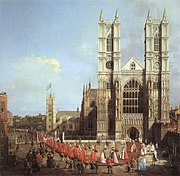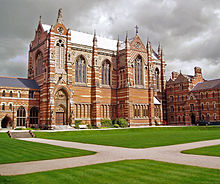| This article needs additional citations for verification. Please help improve this article by adding citations to reliable sources. Unsourced material may be challenged and removed. Find sources: "Oxford Movement" – news · newspapers · books · scholar · JSTOR (May 2015) (Learn how and when to remove this message) |
 Edward Bouverie Pusey
Edward Bouverie Pusey John Henry Newman
John Henry Newman
The Oxford Movement was a movement of high church members of the Church of England which began in the 1830s and eventually developed into Anglo-Catholicism. The movement, whose original devotees were mostly associated with the University of Oxford, argued for the reinstatement of some older Christian traditions of faith and their inclusion into Anglican liturgy and theology. They thought of Anglicanism as one of three branches of the "one, holy, catholic, and apostolic" Christian church. Many key participants subsequently converted to Roman Catholicism.
The movement's philosophy was known as Tractarianism after its series of publications, the Tracts for the Times, published from 1833 to 1841. Tractarians were also disparagingly referred to as "Newmanites" (before 1845) and "Puseyites" after two prominent Tractarians, John Henry Newman and Edward Bouverie Pusey. Other well-known Tractarians included John Keble, Charles Marriott, Richard Froude, Robert Wilberforce, Isaac Williams and William Palmer. All except Williams and Palmer were fellows of Oriel College, Oxford.
History
| Part of a series on the |
| History of the Church of England |
|---|
 Westminster Abbey (1749) by Canaletto Westminster Abbey (1749) by Canaletto |
| Middle Ages (597–1500) |
| Reformation (1509–1559) |
| Elizabethan Church (1558–1603) |
| Jacobean period (1603–1625) |
| Caroline period (1625–1649) |
| 1649–1688 |
| 1700–1950 |
In the early nineteenth century, many of the clergymen of the Church of England, particularly those in high office, saw themselves as latitudinarian (liberal). Conversely, many clergy in the parishes were Evangelicals, as a result of the revival led by John Wesley. Alongside this, the universities became the breeding ground for a movement to restore liturgical and devotional customs which borrowed deeply from traditions before the English Reformation, as well as from contemporary Roman Catholic traditions.
The immediate impetus for the Tractarian movement was a perceived attack by the reforming Whig administration on the structure and revenues of the Church of Ireland (the established church in Ireland), with the Irish Church Temporalities Bill (1833). The Act provided for the merging of dioceses and provinces of the Church of Ireland, and the elimination of Vestry Assessment (church rates or "parish cess"), a cause of grievance in the Tithe War. The bill also made changes to the leasing of church lands. Some politicians and clergy (including a number of Whigs) feared that the Church of England might be disestablished and lose its endowments. John Keble criticised these proposals as "National Apostasy" in his Assize Sermon in Oxford in 1833, in which he denied the authority of the British Parliament to abolish several dioceses in Ireland.
The Gorham Case, in which secular courts overruled an ecclesiastical court on the matter of a priest with somewhat unorthodox views on the efficacy of infant baptism, was also deeply unsettling. Keble, Edward Bouverie Pusey, Newman, and others began to publish a series known as Tracts for the Times, which called the Church of England to return to the ways of the ancient and undivided church in matters of doctrine, liturgy and devotion. They believed that the Church of England needed to affirm that its authority did not come from the authority of the state, but from God.
Even if the Anglican Church were completely separated from the state, it could still claim the loyalty of Englishmen because it rested on divine authority and the principle of apostolic succession. With a wide distribution and a price in pennies, the Tracts succeeded in drawing attention to the views of the Oxford Movement on points of doctrine, but also to its overall approach, to the extent that Tractarian became a synonym for supporter of the movement.
The Tractarians postulated the Branch Theory, which states that Anglicanism, along with Eastern Orthodoxy and Roman Catholicism, form three "branches" of the historic pre-schism Catholic Church. Tractarians argued for the inclusion of traditional aspects of liturgy from medieval religious practice, as they believed the church had become too "plain". In the final tract, "Tract 90", Newman argued that the doctrines of the Roman Catholic Church, as defined by the Council of Trent, were compatible with the Thirty-Nine Articles of the 16th-century Church of England. Newman's eventual reception into the Roman Catholic Church in 1845, followed by Henry Edward Manning in 1851, had a profound effect on the movement.
Publications
Apart from the Tracts for the Times, the group began a collection of translations of the Church Fathers, which they termed the Library of the Fathers. The collection eventually comprised 48 volumes, the last published three years after Pusey's death. They were issued through Rivington's company with the imprint of the Holyrood Press. The main editor for many of these was Charles Marriott. A number of volumes of original Greek and Latin texts were also published. One of the main contributions that resulted from Tractarianism is the hymnbook entitled Hymns Ancient and Modern which was published in 1861.
Influence and criticism

| Part of the Politics series on |
| Toryism |
|---|
 |
| Characteristics |
| General topics |
| People |
| Related topics |
The Oxford Movement was criticised as being a mere "Romanising" tendency, but it began to influence the theory and practice of Anglicanism more broadly, spreading to cities such as Bristol during the 1840s-50s. The Oxford Movement was also criticised as both secretive and collusive.
The Oxford Movement resulted in the establishment of Anglican religious orders, both of men and of women. It incorporated ideas and practices related to the practice of liturgy and ceremony to incorporate more powerful emotional symbolism in the church. In particular, it brought the insights of the Liturgical Movement into the life of the church. Its effects were so widespread that the Eucharist gradually became more central to worship, vestments became common, and numerous Roman Catholic practices were re-introduced into worship. This led to controversies within churches that resulted in court cases, as in the dispute about ritualism.
Many of the Tractarian priests began working in slums. This was partly because bishops refused to give livings to Tractarian priests, and partly due to an ethos of concern for the poor. From their new ministries, they developed a critique of British social policy, both local and national. One of the results was the establishment of the Christian Social Union, of which a number of bishops were members, where issues such as the just wage, the system of property renting, infant mortality and industrial conditions were debated. The more radical Catholic Crusade was a much smaller organisation than the Oxford Movement. Anglo-Catholicism – as this complex of ideas, styles and organisations became known – had a significant influence on global Anglicanism.
Gu Hongming, an early twentieth-century Chinese author, used the concept of the Oxford Movement to argue for a return to traditional Confucianism in China.
End of Newman's involvement and receptions into Roman Catholicism
One of the principal writers and proponents of Tractarianism was John Henry Newman, a popular Oxford priest who, after writing his final tract, "Tract 90", became convinced that the Branch Theory was inadequate. Concerns that Tractarianism was disguised Roman Catholicism were not unfounded; Newman believed that the Roman and Anglican churches were wholly compatible. He was received into the Roman Catholic Church in 1845 and was ordained a Catholic priest two years later. He later became a cardinal (but not a bishop). Writing on the end of Tractarianism as a movement, Newman stated:
I saw indeed clearly that my place in the Movement was lost; public confidence was at an end; my occupation was gone. It was simply an impossibility that I could say any thing henceforth to good effect, when I had been posted up by the marshal on the buttery-hatch of every College of my University, after the manner of discommoned pastry-cooks, and when in every part of the country and every class of society, through every organ and opportunity of opinion, in newspapers, in periodicals, at meetings, in pulpits, at dinner-tables, in coffee-rooms, in railway carriages, I was denounced as a traitor who had laid his train and was detected in the very act of firing it against the time-honoured Establishment.
Newman was one of a number of Anglican clergy who were received into the Roman Catholic Church during the 1840s who were either members of, or were influenced by, Tractarianism.
Other people influenced by Tractarianism who became Roman Catholics included:
- Thomas William Allies, ecclesiastical historian and Anglican priest.
- Edward Badeley, ecclesiastical lawyer.
- Robert Hugh Benson, son of the Archbishop of Canterbury, novelist and monsignor.
- John Chapman, patristic scholar and Roman Catholic priest.
- Augusta Theodosia Drane, writer and Dominican prioress.
- Edgar Edmund Estcourt, canon of St. Chad's Roman Catholic Cathedral, Birmingham.
- Frederick William Faber, theologian, hymn writer, Oratorian and Roman Catholic priest.
- Robert Stephen Hawker, poet and Anglican priest (became a Roman Catholic on his deathbed).
- James Hope-Scott, barrister and Tractarian (received with Manning).
- Gerard Manley Hopkins, poet and Jesuit priest.
- Cecil Chetwynd Kerr, Marchioness of Lothian, church founder and philanthropist.
- Ronald Knox, Biblical text translator and Anglican priest.
- Thomas Cooper Makinson, Anglican priest.
- Henry Edward Manning, later Cardinal Archbishop of Westminster.
- St. George Jackson Mivart, biologist (later interdicted by Cardinal Herbert Vaughan).
- John Brande Morris, Orientalist, eccentric and Roman Catholic priest.
- William Pope, priest who seceded from Anglicanism to the Church of Rome in 1853
- Augustus Pugin, architect.
- Richard Sibthorp, Anglican and Roman Catholic priest (the first to convert, in 1841; later reconverted to Anglicanism)
- William Gowan Todd, Roman Catholic priest
- William George Ward, theologian.
- Lurana White, SA, nun and co-founder with Servant of God Paul Wattson, SA of the Society of the Atonement.
Others associated with Tractarianism
- Edward Burne-Jones
- Richard William Church
- Margaret Anna Cusack
- George Anthony Denison
- Philip Egerton
- Alexander Penrose Forbes
- William Ewart Gladstone
- George Cornelius Gorham
- Renn Dickson Hampden
- Walter Farquhar Hook
- William Lockhart
- John Medley
- James Bowling Mozley
- Thomas Mozley
- John Mason Neale
- Frederick Ouseley
- William Upton Richards
- Christina Rossetti
- Lord Salisbury
- James Henthorn Todd
- Nathaniel Woodard
- Charlotte Mary Yonge
See also
Portals:- Anglican Breviary
- Anglican Communion
- Cambridge Camden Society
- Confraternity of the Blessed Sacrament
- Guild of All Souls
- Library of Anglo-Catholic Theology
- Neo-Lutheranism
- Personal Ordinariate of Our Lady of Walsingham
- Society of the Holy Cross
- Society of King Charles the Martyr
- Society of Mary (Anglican)
- Crypto-papism
References
- "The Church of England (the Anglican Church)". victorianweb.org. Retrieved 7 December 2015.
- Britannica, The Editors of Encyclopaedia. "Oxford movement". Encyclopedia Britannica, 20 Aug. 2020
- ^ "Oxford Movement, The", The Episcopal Church
- Shelley, Bruce L. (2013). Church History in Plain Language. p. 387.
- "A Short History of the Oxford Movement". Mocavo. Archived from the original on 26 December 2014. Retrieved 4 March 2014.
- Cobb, Peter G. (1988). The Oxford Movement in Nineteenth-Century Bristol. Bristol: Bristol Historical Association.
- Walsh, Walter (1899). The Secret History of the Oxford Movement (5th ed.). London Church Association.
- The Story of a Chinese Oxford Movement.
- Murray, Placid, ed. (2004). Newman the Oratorian. Gracewing. pp. 53–54. ISBN 0-85244-632-2.
- "The Tractarian Movement". victorianweb.org. Retrieved 7 December 2015.
Further reading
- Bexell, Oloph, "The Oxford Movement as received in Sweden." Kyrkohistorisk årsskrift. Publications of the Swedish Society of Church History 1:106 (2006).
- Brown, Stewart J. & Nockles, Peter B. ed. The Oxford Movement: Europe and the Wider World 1830–1930, Cambridge: Cambridge University Press, 2012.
- Burgon, John, Lives of Twelve Good Men. Includes biography of Charles Marriott.
- Chadwick, Owen. Mind of the Oxford Movement, Stanford: Stanford University Press, 1960.
- Church, R. W., The Oxford Movement: Twelve Years, 1835–1845, ed. and with an introd. by Geoffrey Best, in series, Classics of British Historical Literature, Chicago: University of Chicago Press, 1970. xxxii, , 280 p. ISBN 0-226-10619-5 (pbk.)
- Church, R. W. The Oxford Movement: Twelve Years, 1833–1845, London: Macmillan & Co., 1891.
- Crumb, Lawrence N. The Oxford Movement and Its Leaders: a bibliography of secondary and lesser primary sources. (ATLA Bibliography Series, 56). Lanham, MD: Scarecrow Press, 2009.
- Dearing, Trevor Wesleyan and Tractarian Worship. London: Epworth Press, 1966.
- Dilworth-Harrison, T. Every Man's Story of the Oxford Movement. London: A. R. Mowbray & Co., 1932.
- Faught, C. Brad. The Oxford Movement: a thematic history of the Tractarians and their times, University Park, PA: Pennsylvania State University Press, 2003, ISBN 978-0-271-02249-9
- Halifax, Charles Lindley Wood, Viscount, The Agitation Against the Oxford Movement, Office of the English Church Union, 1899.
- Hall, Samuel. A Short History of the Oxford Movement, London: Longmans, Green and Co., 1906.
- Herring, George (2016) The Oxford Movement in Practice. Oxford University Press (based on the author's D.Phil. thesis; it examines the Tractarian parochial world from the 1830s to the 1870s)
- Hoppen, K. Theodore. "The Oxford Movement" History Today (Mar 1967) Vol. 17 Issue 3, p145-152 online
- Hutchison, William G. The Oxford Movement, being a Selection from Tracts for the Times, London: Walter Scott Pub. Co., 1906.
- Kelway, Clifton (1915) The Story of the Catholic Revival. London: Cope & Fenwick
- Kendall, James. "A New Oxford Movement in England," The American Catholic Quarterly Review, Vol. XXII, 1897.
- Leech, Kenneth & Williams, Rowan (eds) Essays Catholic and Radical: a jubilee group symposium for the 150th anniversary of the beginning of the Oxford Movement 1833–1983, London: Bowerdean, 1983ISBN 0-906097-10-X
- Liddon, Henry Parry, Life of E. B. Pusey, 4 vols. London, 1893. The standard history of the Oxford Movement, which quotes extensively from their correspondence, and the source for much written subsequently. The Library of the Fathers is discussed in vol. 1 pp. 420–440. Available on archive.org.
- Norman, Edward R. Church and Society in England 1770–1970: a historical study. Oxford: Clarendon Press, 1976, ISBN 0-19-826435-6.
- Nockles, Peter B. The Oxford Movement in Context: Anglican High Churchmanship 1760–1857. Cambridge: Cambridge University Press, 1996.
- Nockles, Peter B., "The Oxford Movement and its historiographers. Brilioth's 'Anglican Revival' and 'Three Lectures on Evangelicalism and The Oxford Movement' revisited." Kyrkohistorisk årsskrift. Publications of the Swedish Society of Church History 1:106 (2006).
- Nye, George Henry Frederick. The Story of the Oxford Movement: A Book for the Times, Bemrose, 1899.
- Ollard, S. L. A Short History of the Oxford Movement, A. R. Mowbray & Co., 1915.
- Pereiro, J. 'Ethos' and the Oxford Movement: At the Heart of Tractarianism. Oxford: Oxford University Press, 2007.
- Pfaff, Richard W. "The Library of the Fathers: the Tractarians as Patristic translators," Studies in Philology; 70 (1973), p. 333ff.
- Skinner, S. A. Tractarians and the Condition of England: the social and political thought of the Oxford Movement. (Oxford Historical Monographs.) Oxford: Clarendon Press, 2004.
- Wakeling, G. The Oxford Church Movement: Sketches and Recollections, Swan Sonnenschein & Co., 1895.
- Walworth, Clarence A. The Oxford Movement in America. New York: United States Catholic Historical Society, 1974 (Reprint of the 1895 ed. published by the Catholic Book Exchange, New York).
- Ward, Wilfrid. The Oxford Movement, T. C. & E. C. Jack, 1912.
- Webb, Clement Charles Julian. Religious Thought in the Oxford Movement, London: Macmillan, 1928.
External links
- Tractarianism (Schaff-Herzog Encyclopedia of Religious Knowledge)
- The Oxford Movement. BBC Radio 4 discussion with Sheridan Gilley, Frances Knight & Simon Skinner (In Our Time, Apr 13, 2006)

